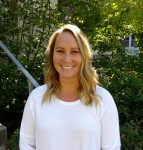
Graduate student Krista Glowacki has developed an innovative Exercise and Depression Toolkit for Canadian healthcare providers who work with adults with depression. The kit is designed to support healthcare professionals in exploring exercise as a treatment option for depression in collaboration with their patients.
As a Kinesiology PhD candidate and registered occupational therapist who worked for the Canadian Mental Health Association with adults with a diagnosed mental illness, Krista’s research focuses broadly on the relationship between physical activity and mental health, and she has led the development of this project under the supervision of UBC Kinesiology faculty member, Dr. Guy Faulkner.
Inspired by her experiences working in the mental health field, the three-part Exercise and Depression Toolkit is an effort to begin integrating exercise into healthcare services delivery, as access to exercise therapy is not yet standardized in most mental health services in Canada. “After personal and family experiences with mental illness, I started recognizing the benefits of engaging in regular exercise for managing mental health,” she says. “When working as an Occupational Therapist, I saw benefits for individuals who would engage in our Active Recovery program. People became more confident, socialized more, and had noticeable improvement and changes with their mood.”
According to the development team, this toolkit was built through a rigorous evidence-based process that involved extensive consultation with adults who have lived with depression, health care providers, exercise professionals and researchers. “Ultimately, we hope that the Exercise and Depression Toolkit will be a starting point to exercise becoming a utilized and accessible treatment [option] to help improve the lives of Canadians living with depression.”
For more information about how and why the toolkit was developed, you can read the academic paper published in the October issue of “Mental Health and Physical Activity” journal here, as well as the article published in Centre for Active Living here.